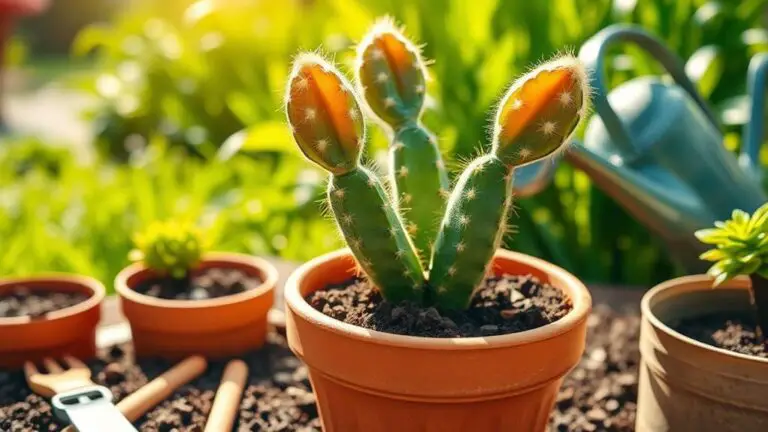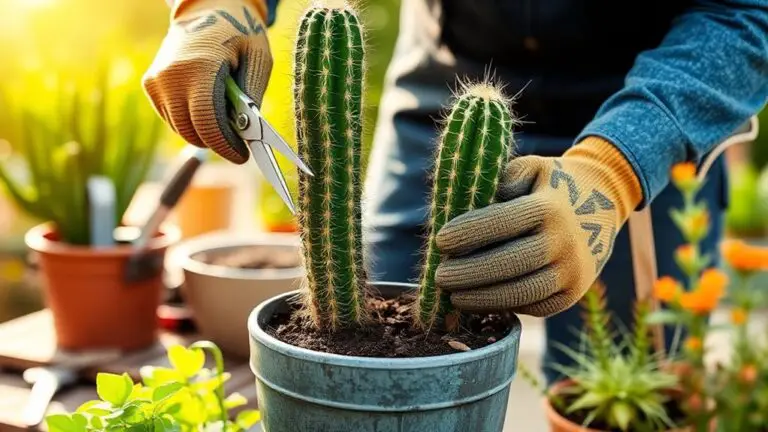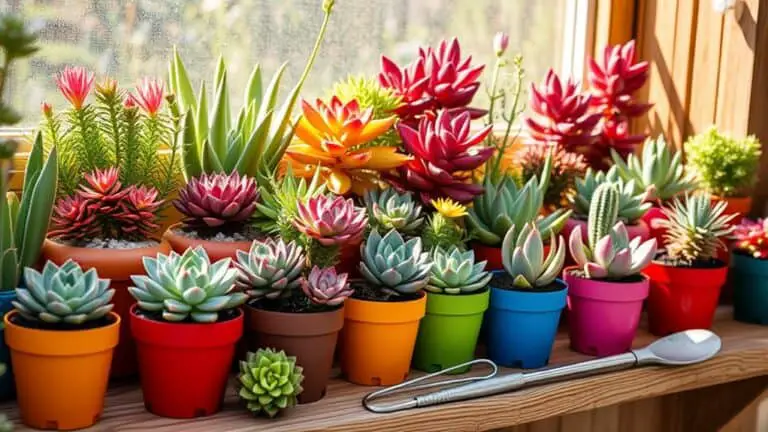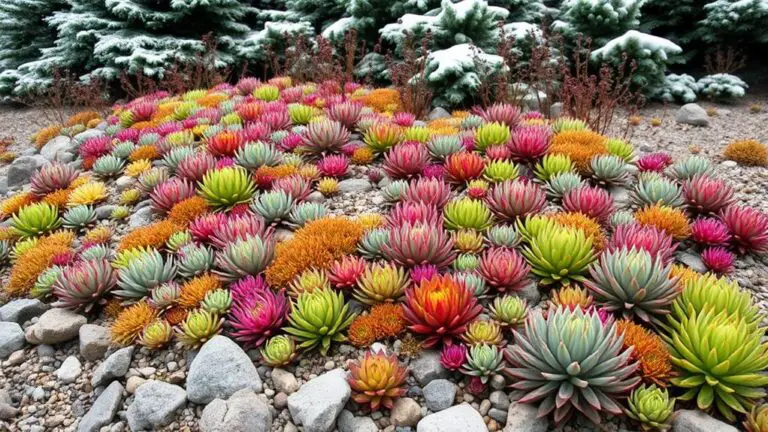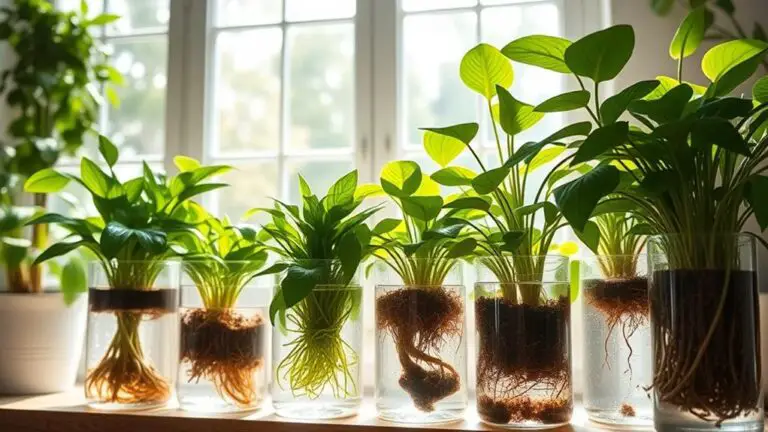10 Smart Ideas for a Clutter-Free Garden Organization
Organizing your garden doesn't have to be overwhelming if you incorporate a few smart ideas to keep things tidy and functional. Start by making the most of your vertical space with wall-mounted shelves and pegboards. This way, you can keep tools and supplies off the ground and within easy reach. Don't stop there; creating specific zones for various plants and tasks can drastically improve your garden's usability. Imagine having clear storage bins, each labeled and easily accessible, ensuring you spend more time enjoying your garden rather than searching for misplaced items. Want to know more? Let's explore further.
Maximize Vertical Space

One of the best ways to keep your garden organized and clutter-free is to maximize vertical space. By using this approach, you can make the most of your garden area while keeping it tidy.
Start by installing wall-mounted shelves. These shelving units are perfect for holding pots and tools, freeing up the ground space for easy movement.
Another great idea is to use pegboards. Pegboards can be customized with hooks to hang your tools, maximizing vertical space and ensuring that everything is within easy reach.
For those bulkier items like ladders or seasonal decorations, consider overhead storage racks. These racks keep large items out of the way, giving you more floor space for other uses.
Tall plant stands can also help you save ground space. They allow you to display a variety of plants vertically, making your garden look organized and aesthetically pleasing.
Vertical gardening systems, like wall planters or trellises, can boost your garden's productivity by letting you grow more plants in a smaller footprint.
Following these organization tips will help you create a clutter-free garden that's both functional and beautiful.
Use Clear Storage Bins
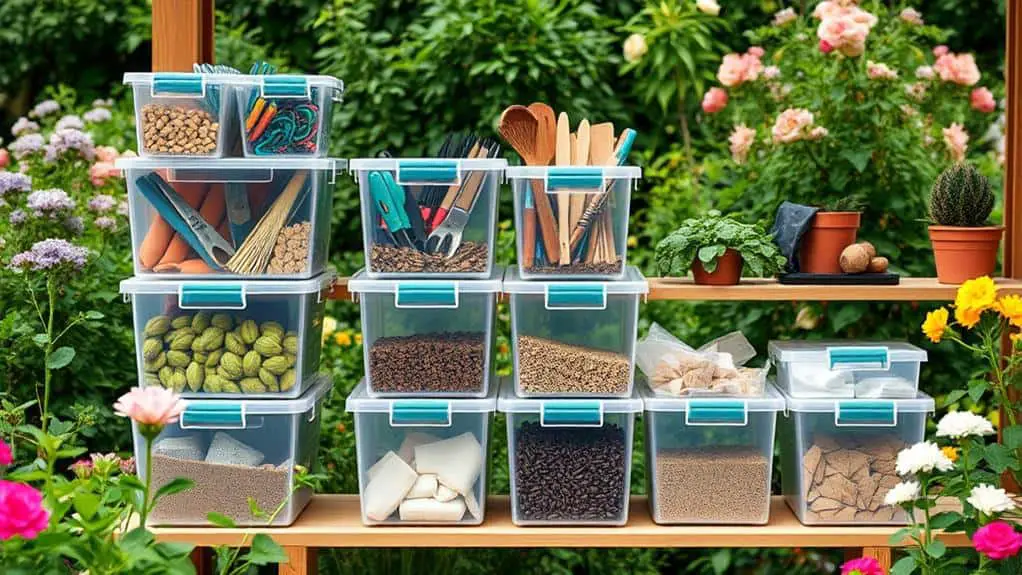
Clear storage bins are an incredibly practical solution for keeping your garden organized. They allow you to see exactly what's inside, so you don't waste time rummaging through cluttered spaces. Whether it's gardening tools, seeds, or supplies, everything is visible and easy to find.
One of the best organization and storage ideas is to label these clear bins. This makes identifying their contents quick and efficient, saving you time when you're in the middle of a gardening task. Plus, using stackable clear storage bins helps you maximize vertical space in your shed or garage. This way, you can better utilize available areas while keeping your items easily accessible.
Clear storage bins also protect your gardening supplies from dust and moisture, ensuring that your tools and materials remain in good condition. When you invest in durable weather-resistant bins, you prolong the life of your gardening essentials. These bins are perfect for decluttering and organizing your garden space effectively.
Here's a quick table to summarize these benefits:
| Benefit | Description | Outcome |
|---|---|---|
| Easy Visibility | Contents are visible without opening the bins | Saves time |
| Labeling | Quick identification of contents | Enhanced efficiency |
| Stackable and Weather-Resistant | Maximizes space and protects from dust and moisture | Prolonged life of supplies |
Using clear storage bins is a smart, practical way to keep your garden neat and efficient.
Install Pegboards
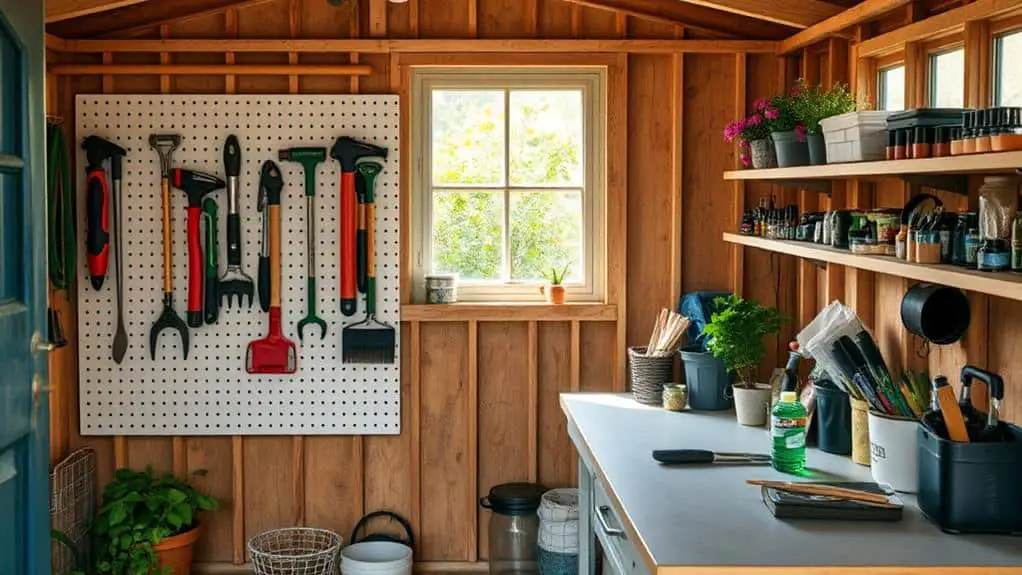
After organizing your supplies with clear storage bins, another effective method to keep your garden space tidy is by installing pegboards. Pegboards are great for organization because they let you use vertical space efficiently. You'll love how easy it's to hang your tools, like shovels and rakes, with sturdy hooks. This way, you can see everything at a glance and grab what you need quickly.
Pegboards are usually made from durable materials like MDF or metal, so they can handle the weight of heavier tools. Installing them is straightforward and can be done with basic tools and hardware. In just a few hours, you can have a pegboard up and ready to use. It's a quick and effective way to improve your garden storage solutions.
One of the best things about pegboards is how customizable they are. You can find a variety of hooks, baskets, and shelves to fit your specific needs. This flexibility means you can create an organization system that works perfectly for you.
Create Zones
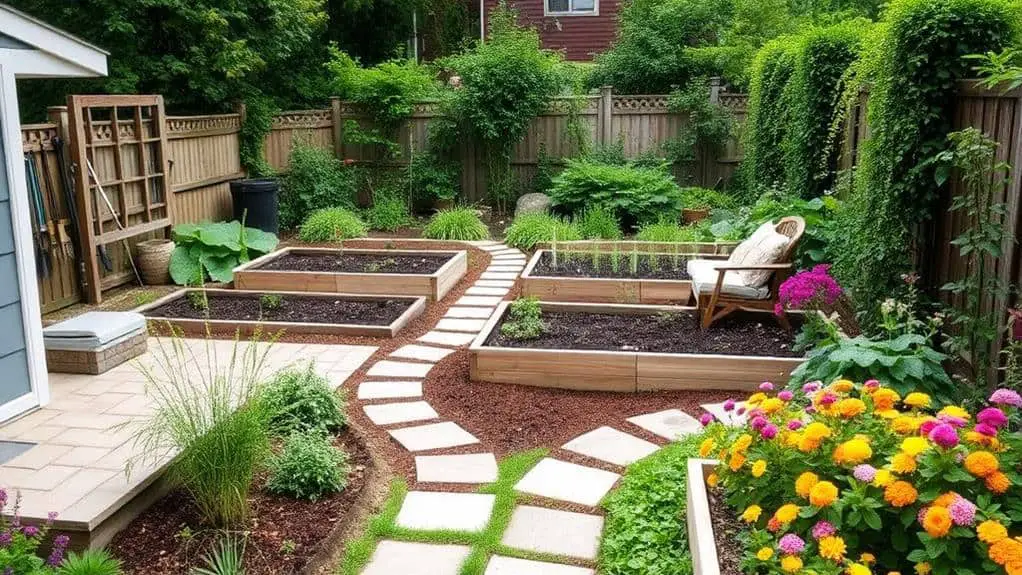
Creating zones in your garden can revolutionize your organization and efficiency. By designating specific areas for vegetables, flower beds, and tool storage, you transform your garden into an organized haven. This clear structure makes it easier to locate items and perform tasks efficiently. Imagine having all your tools in one place and knowing exactly where to plant your flowers. It saves time and reduces frustration.
Labeling each zone with signs or color-coded markers can further enhance this organization. You'll quickly identify each area's purpose, making your gardening activities smoother. Grouping similar plants and tools together in these zones streamlines tasks like watering and weeding. Everything you need is within reach, which makes maintaining your garden less of a chore.
Think about establishing pathways between these zones. This not only improves accessibility but also keeps your garden tidy. Proper lighting along these paths can guarantee you see clearly, even in the early morning or late evening.
Regularly reassessing and adjusting these zones based on the season or changes in your gardening activities can optimize your space in your backyard. This way, you're always getting organized and making the most of your storage space.
Repurpose Old Furniture

Transforming your garden into an organized space doesn't have to mean buying new storage solutions. Repurposing old furniture can offer creative and practical storage solutions for your garden tools and supplies.
For instance, an old dresser can be an excellent spot to store small tools, gloves, and seeds. The drawers keep everything hidden yet easily accessible.
If you have a vintage ladder lying around, consider using it as a plant stand. This not only showcases your flowers or herbs but also helps you make the most of vertical space.
Similarly, old wooden crates can be stacked or mounted on walls to create open shelving. These shelves are perfect for displaying gardening essentials or even decorative items, adding charm to your garden.
An old bench is another versatile piece. It can provide a cozy seating area while also doubling as a storage compartment for garden tools or cushions.
Repurposed furniture promotes sustainability by reducing waste and allows you to customize garden organization to fit your specific needs and aesthetic preferences.
Seasonal Maintenance
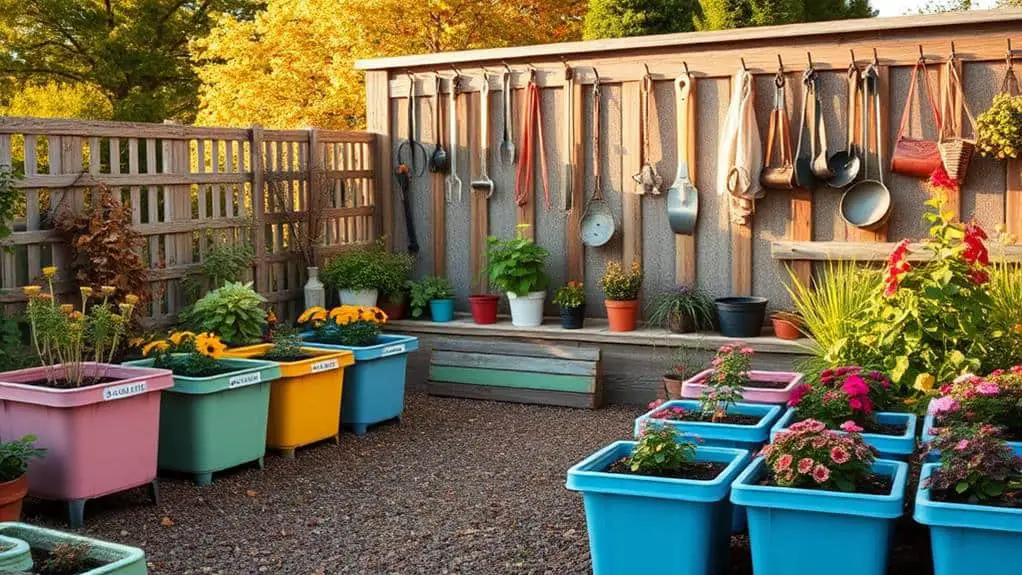
Keeping your garden in top shape year-round involves regular seasonal maintenance. Start by conducting seasonal inspections of your garden. This will help you identify and address any pest infestations early, ensuring a healthy environment for your plants.
Next, focus on organizing your shed. Rotate seasonal items, like garden tools and decorations, to the front of your storage areas. This makes them easy to access when you need them most.
When it comes to storing off-season gardening supplies, use labeled bins. This keeps everything tidy and prevents clutter from taking over your shed or garage.
Don't forget to regularly check and maintain garden tools. Sharpen blades and clean off any rust so your tools perform their best whenever you need them.
Implement a seasonal cleaning schedule. Remove debris, dead plants, and weeds to promote a tidy and productive garden space.
Tool Organization Techniques
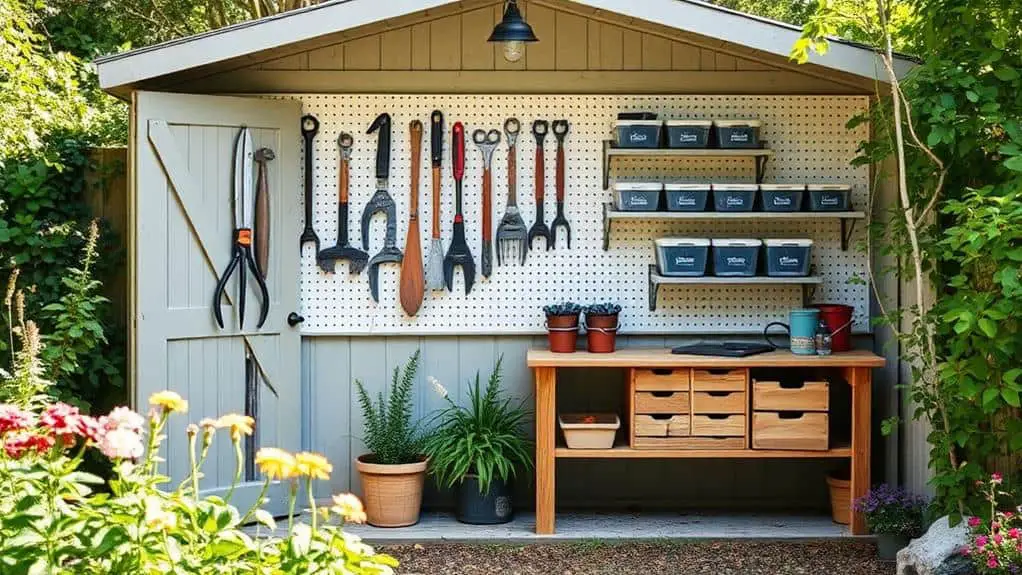
Although maintaining an organized garden shed might seem challenging, implementing effective tool organization techniques can make a significant difference.
Start by installing hooks and hangers on walls or inside shed doors. This keeps gardening tools off the floor and easily accessible. You can find these for $10-$50.
Next, try using magnetic strips to hold metal tools like scissors and trowels. These strips keep your surfaces clear and allow for quick access. They're affordable, typically costing between $10-$30.
For smaller tools and supplies, consider using labeled clear plastic storage bins. These bins help you categorize items, improve visibility, and protect them from dust. Clear bins cost between $20-$50.
Repurposing old furniture, like bookshelves or dressers, can create unique storage solutions in your tool shed. This organizing tip is cost-effective and environmentally friendly.
Efficient Storage Solutions

Efficient storage solutions can revolutionize your garden shed by maximizing space and enhancing organization. By using vertical storage solutions like wall-mounted shelves and pegboards, you can keep your gardening tools off the ground and create a tidy, efficient environment. Clear, labeled storage bins are a smart storage idea to keep seasonal items and gardening supplies visible and protected from dust and moisture.
Consider using rolling carts for mobility, which makes it easy to transport tools, soil, and plants around your garden or shed without the need to carry heavy items. Stackable storage options are another great way to use vertical space efficiently, helping you organize and access multiple items without cluttering the floor.
Creating designated zones in your garden shed for different activities, such as planting or tool storage, can streamline organization and enhance workflow efficiency. These zones help you know exactly where everything belongs, making your outdoor shed organization a breeze.
Here's a handy reference table for these tips:
| Storage Solution | Benefits | Example Uses |
|---|---|---|
| Vertical Storage | Maximizes space | Wall-mounted shelves, pegboards |
| Storage Bins | Easy visibility, protection | Seasonal items, gardening supplies |
| Rolling Carts | Mobility, less lifting | Transporting tools, soil, plants |
| Stackable Storage | Efficient vertical use | Organizing small items |
| Designated Zones | Streamlines activities | Planting area, tool storage |
Kids' Storage Area
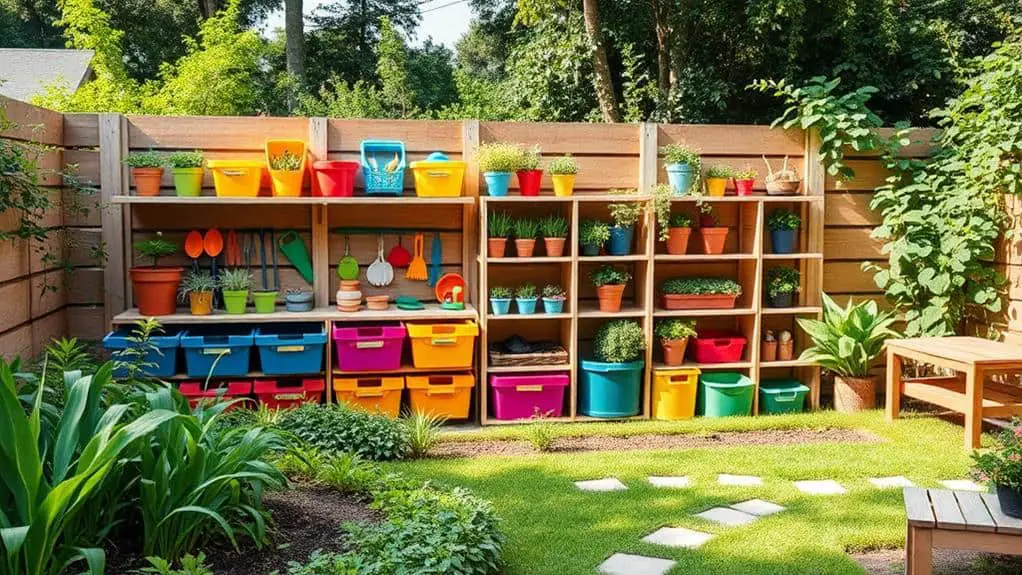
Creating a kids' storage area using colorful, labeled bins will make it easy for children to organize their outdoor toys and equipment.
Use a mix of open shelves for frequently used items and closed containers for seasonal toys to keep everything tidy.
Low-height shelving or a small outdoor bench allows kids to access their sports equipment independently, promoting responsibility and organization habits.
Colorful Storage Bins
Transforming a cluttered garden into a well-organized haven for your kids can be as simple as introducing colorful storage bins. These bins don't just brighten up the space; they make it easier for children to find and put away their toys and outdoor games.
Using various sizes of bins provides better organization. For example, larger bins can hold sports equipment, while smaller ones are perfect for art supplies.
Labeling each bin with pictures or words is one of the most effective organizing tips. It helps children learn to categorize and return items to their designated places, promoting a sense of responsibility.
Stacking bins can save space and create a tidy look, and since they're made of durable plastic, they'll last even in outdoor conditions.
For more helpful tips, keeping your shed and garden area clutter-free involves creating a designated storage area for kids' items. This encourages outdoor play and keeps the garden space enjoyable for everyone.
By using colorful storage bins, you can even incorporate storing seeds and other gardening tools, making outdoor storage both functional and fun.
With these straightforward strategies, your garden will be both beautiful and organized.
Toy Organization Strategies
When it comes to organizing your kids' toys in the garden, designating a specific area can make a world of difference. Start by setting up colorful, labeled bins. This simple step encourages kids to return items after playtime, promoting both responsibility and organization.
You'll find that using stackable containers is a fantastic way to maximize vertical space. These containers keep frequently used outdoor toys easily accessible while maintaining a clutter-free environment.
A designated storage solution, like a weather-resistant toy chest, protects toys from the elements and keeps your garden tidy. Implementing the "one in, one out" rule can also help. For every new toy brought into the area, verify an old or unused one is donated or discarded. This strategy considerably reduces overall clutter.
Encourage your children to participate in regular clean-up sessions. Turning these sessions into a fun game helps them develop organizational skills while keeping the play area neat.
Accessible Sports Equipment
A well-organized kids' sports storage area can make a significant difference in keeping your garden clutter-free and guaranteeing equipment is always ready for playtime.
Start by designating a colorful storage area using bins or baskets for children's sports equipment. This encourages organization and makes items easily accessible for outdoor fun.
Utilize labeled containers to categorize different types of sports gear, such as balls, bats, and nets. This fosters a sense of responsibility and makes cleanup simpler for kids.
Implement vertical storage solutions, like wall-mounted racks or pegboards, to keep frequently used sports items off the ground and within easy reach. It's a great way to maximize space and guarantee everything has a place.
Encourage children to participate in organizing their sports equipment by implementing a "return after use" rule. This promotes accountability and tidiness in their play area.
Additionally, use durable, weather-resistant storage options to protect sports equipment from the elements. This guarantees that items remain in good condition and are always ready for use.
Safety and Weatherproofing
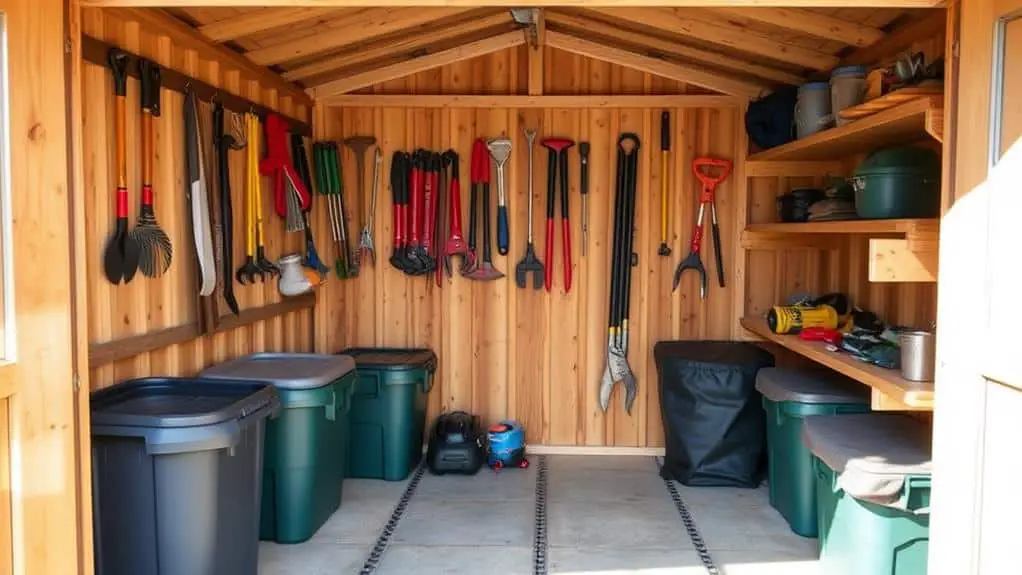
To create a safe and weatherproof garden shed, start by securing hazardous materials like fertilizers and pesticides in locked cabinets. This guarantees safety for children and pets.
Keeping your shed organized helps you find tools and equipment quickly. Use weather-resistant storage solutions like plastic bins or metal cabinets to protect everything from rain and humidity.
Proper ventilation is essential. Install vents or windows to reduce moisture buildup, which can lead to mold and rust on your tools. Regularly inspect your shed for leaks or structural issues. If you find any gaps, seal them and apply weatherproofing sealants to protect against the elements. This will keep your storage space dry and extend the life of your shed.
Maintaining the exterior of your shed is also important. Apply fresh paint or stain every few years to prevent rot and decay. This not only keeps your shed looking good but also makes it last longer.
Frequently Asked Questions
How Can I Prevent Pests From Infesting My Garden Storage Areas?
You'll want to keep pests out by sealing any cracks or openings, storing items in airtight containers, and regularly cleaning the area. Use natural repellents like cedar or lavender, and remove any food sources that attract pests.
What Are Some Eco-Friendly Ways to Dispose of Garden Waste?
You can compost your garden waste, turning it into nutrient-rich soil. Mulching is another option, using organic materials to enrich your garden. Consider a local green waste recycling program for larger debris.
How Do I Keep My Garden Tools Rust-Free?
To keep your garden tools rust-free, clean them after each use, dry them thoroughly, and store them in a dry place. Apply a light coat of oil to metal parts to prevent moisture from causing rust.
What Are the Best Practices for Storing Garden Seeds?
Store your garden seeds in airtight containers to keep them dry. Label each container with the seed type and date. Keep them in a cool, dark place, like a basement or refrigerator, to maintain their viability.
How Can I Incorporate Composting Into My Garden Organization Plan?
To incorporate composting into your garden organization plan, designate a specific area for a compost bin. Regularly add kitchen scraps and garden waste. Turn the compost frequently to speed up decomposition and create nutrient-rich soil.
Conclusion
By putting these smart ideas into action, you'll keep your garden neat and enjoyable. Use vertical space, clear bins, and pegboards to stay organized. Create zones for plants and tools, and repurpose old furniture for unique storage. Don't forget to set up a kids' area and guarantee everything's safe and weatherproof. With these tips, your garden will be tidy and ready for all to enjoy. You've got this—happy gardening!


